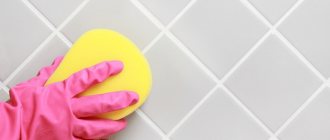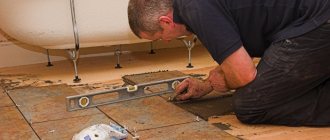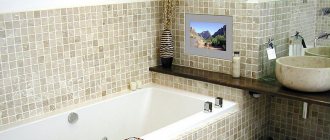Grouting tile joints is no less important a process than the cladding itself. They do this not only for the sake of beauty, although this means a lot, but also in order to protect the finishing layer from the effects of adverse factors. High-quality grout does not allow moisture to pass through, prevents fungi from developing and dirt from accumulating, which prolongs the life of the tile. To properly grout the seams, you should familiarize yourself with the application technology in more detail, as well as find out which composition is best suited for the bathroom.
Do-it-yourself grouting of tiles in the bathroom
Types of grout based on material of manufacture
Depending on the material used as the main component in the manufacture of grout, inter-tile fillers are divided into the following types.
Cement
According to EN 13888, cement-based grouts are designated CG and, depending on their water absorption and abrasion characteristics, are divided into two classes.
Cement grouts are intended for filling joints on non-deformable monolithic bases (brick or block masonry, cement plasters and screeds). Suitable for use indoors and outdoors, on walls or floors. In addition to cement and fine sand, the aggregates contain mineral or chemical pigments and polymer modifiers that increase the plasticity of the finished mixtures. Depending on the plasticity (amount of modifiers and sand fractionation), the product is intended for filling narrow (up to 6 mm) as well as wide (up to 40 mm) joints.
The advantages of cement-based grouts include their versatility, the ability to be tinted in any shade, and their low cost. In addition, cement grouts, with a well-chosen shade, can hide minor defects and unevenness in tile laying, which, combined with the ease of preparation and application, makes this type of grout the most widely used. The disadvantages of cement compositions include their lack of resistance to moisture and their tendency to accumulate contaminants that literally eat into the coating.
Epoxy
Epoxy resin-based grouts are classified as reactive grouts and are designated RG according to EN 13888. Such grouts are almost completely waterproof. Their main area of application is swimming pool bowls and various tanks, where it is necessary to ensure maximum impermeability of the facing carpet, as well as industrial and laboratory complexes with special requirements for the strength and acid resistance of the floor covering. In domestic premises, using two-component grout is very problematic: the resulting mass has a high viscosity and does not fit well into narrow joints. The minimum application thickness is 3–4 mm.
But thanks to the high strength, durability and ease of cleaning the surface, the cost of filling joints with epoxy is completely worth it. In addition, hardened epoxy resin is resistant to any household chemicals and has a rich color that practically does not change throughout the entire life of the material.
Another advantage of using epoxy joint filler is the possibility of decorating with metal powder, which is added to the composition during its preparation. Such seams in the bathroom look original and attractive.
The main disadvantage of epoxy grouts is the price; on average, they are five times more expensive than cement grouts.
Polyurethane
Polyurethane grouts are made on the basis of aqueous dispersions of polyurethane resins. This product is a one-component composition, supplied in a sealed container (plastic bucket) and is completely ready for use. Polyurethane has high mechanical resistance, does not wash out, and forms a durable waterproof coating.
The recommended application width is from 1 to 6 mm.
Note! During long-term storage, the mixture may lose some of its moisture and appear dry. You just need to sprinkle a little water from a spray bottle and mix.
Polyurethane grouts are even more expensive than epoxy grouts, and this is their main drawback.
Silicone
Silicone grout (sealant) is sold in plastic tubes and is squeezed out with a syringe gun through a thin spout, which allows you to seal even the narrowest seams and crevices. Silicone grout has high adhesion to all types of tiles and most building materials, including those with a smooth and glossy surface. In conditions of high humidity, it is better to use moisture-resistant sanitary sealants, which are less susceptible to the formation of fungi, mold and other microorganisms on their surface. Available in a wide range of colors, which allows you to choose the composition for any shade of tile.
Silicone joint filler is designed for sealing corner joints, wall and floor tile junctions, as well as sanitary equipment to wall cladding (sinks, bathtubs, showers and trays). It is not used for grouting tile joints.
Note! The optimal ratio of the thickness of the sealant layer to its width is 1:2. If it is necessary to seal a deep seam or joint, it is recommended to place a tubular sealant made of foamed polyethylene into it, and apply a small layer of silicone sealant on top.
Correct technology for sealing deep expansion joints.
Latex
The term “latex grout” most often refers to latex additives added to cement mortars, tile adhesives and grouts to increase their ductility and other characteristics.
Latex additive for cement mixtures.
Additives are made from aqueous dispersions of synthetic resins and are used to add to solutions and adhesives instead of or together with water. In addition to increasing the plasticity and workability of cement compositions, additives increase the following indicators:
- Elasticity, which allows the use of solutions and grouts for heated floors and deformable bases.
- Abrasion resistance.
- Adhesion of compounds to smooth surfaces (stickiness).
- Reduce porosity, water saturation and tendency to contamination of cement mortars.
When introduced into colored grout, the additive does not affect the shade, but prevents it from discoloring and being washed out from the surface during use.
Furanic
Grouts made from furan resins have a dark, often black color. After curing, the grout practically does not absorb moisture, is resistant to acids and some chemical compounds, and ultraviolet radiation. During the manufacturing process, latex additives are introduced into the raw materials, which makes the hardened coating sufficiently elastic and resistant to mechanical, vibration and deformation loads.
The compositions are difficult to work with and toxic, so they are not used in residential premises; their main area of application is industrial and production facilities.
Impregnation for seams between ceramic tiles: material properties
To create a coating on the seams between the tiles that resists water and cleaning agents, it is necessary to treat the tile seams with a special impregnation.
Impregnation allows:
- Provide a hydrophobic coating;
- Prevent the appearance of dirt on the seam;
- Effective against fungus.
As an impregnation, a water repellent having a liquid consistency, a polymer varnish that can penetrate to the base of the grout, or sealants based on silicone or acrylic can be used. Impregnation is applied no earlier than a week after jointing, and the surface of the joints must be dry.
It may happen that the impregnation changes the color of the grout, so before work a trial treatment is necessary on an area that is not conspicuous.
You need to impregnate the seams with water repellents using a thin brush. If the solution gets on the tiles, they may become cloudy, so in order not to spoil the finish, you need to seal the tiles around the edges with masking tape.
Tips for choosing a composition
Knowing the purpose and main characteristics of various types of grout, it is quite easy to decide on the required composition:
- For relatively dry areas of the bathroom, where splashes only occasionally reach, a regular cement composition is suitable.
- To fill joints in wet areas, for example, in a shower, it is better to use waterproof mixtures: epoxy, polyurethane or cement with additives.
Also, when choosing the type of filler for joints, the type of base: stone wall or sheet cladding is taken into account in order to select a material with the required degree of elasticity.
In addition, when choosing a grout, you should pay attention to the structure of the tile itself:
- If the surface of the ceramic is glossy, you should not use coarse-grained grouts, but rather fill the seams with finely dispersed cement grout.
- The shiny "glass" joint created by using epoxy aggregates works well with mosaics and colored glass tiles.
- It is best to fill the joints between porous and relief tiles with coarse-grained cement or polyurethane fugue.
Tile cleaning products
Edding 8200 is a colorful composition for touching up joint surfaces. It contains waterproof ink. It is produced in the form of a marker for more convenient application. You can find white and black markers with a line thickness of no more than 0.4 centimeters.
Pufas cement-ex is a product for removing cement mortar from tiles. Can be used on regular tiles, clinker and terrace tiles. The product is also used as a bath and sink cleaner.
Colored stain remover is used to clean tiles from stains of varying severity and nature of formation. Also suitable for washing natural stone, porcelain stoneware and all types of marble.
Pufas frische fuge. This is a colorful composition for easy renovation of seams. Not recommended for regular use. It is produced exclusively in white colors, but the addition of color is allowed.
Kiilto clean is an aggressive cleaning agent based on various acids. It is used to clean tiles from serious stains, so you should not use it every day.
Return to content
Nuances of choosing a shade
The universal rule for choosing the color of the grout is to match or slightly darker/lighter than the shade of the tile. Another universal option is to use a white fugue, which matches most shades of ceramic cladding, visually slightly expands the bathroom, and also hides minor unevenness in the edges of the tiles and errors made during its installation better than other shades.
For the floor, it is recommended to select dark shades to fill the joints: this will make accumulated dirt and dust less noticeable. White grout on the floor will turn gray in just a few months.
For finishes with a rich pattern or made of multi-colored tiles, a transparent aggregate or a special “chameleon” mixture, which has a different shade from different angles, is suitable.
Another interesting option is to add metallic powder of golden or silver color to the fugue, which makes the seams original and provocative. But it is worth remembering that this method of highlighting seams is suitable for certain design styles.
Advice! If you want to use a contrasting color to fill the seams, you should be guided not only by your taste, but also by the compatibility of shades so that the cladding does not look tacky.
A detailed article about how to choose grout is here.
Painting and whitewashing seams
The easiest and almost instant way to update tile seams is to tint them. This method has one significant drawback - the effect will last no more than six months, after which the grout will need to be renewed again. Also, most paint compositions cannot be used in humid environments.
Another non-radical way to improve seams is to apply a new grout material on top of the old one. This operation is only possible if the seams are deep enough. New grout will need about two millimeters of depth.
All necessary consumables can be purchased at any hardware or hardware store.
If you decide to use paint compounds, then it is important to know that they can be used not only to renew seams, but also to restore damaged areas. That is, the paint can be applied not only over the old grout, but also used as a grouting material, only this will require applying a larger layer.
The paint is quite easy to use. The first step is to thoroughly clean the area from possible contaminants, for example, plaque or mold. Then you need to carefully apply the paint to the tile joint and wait for it to dry.
Painting seams
If you catch a tile during the touch-up process, you need to remove the excess with a rag. The time required for the composition to dry is indicated on its packaging. There you can also find some recommendations for its use.
Return to content
How to calculate the amount of grout
As a rule, manufacturers indicate on the packaging the approximate consumption of grout per 1 m² of cladding. The easiest way to calculate the amount of grout required is to use a special table that shows the consumption depending on the width of the joint and the size of the tile.
Another option is to do the calculation yourself. The following tile parameters are taken into account:
- length (A);
- width (B);
- thickness (h);
- planned seam width (d).
The density of the ready-to-use mixture (P) is also required for the calculation. The average density of cement grout is 1.7–1.8 kg/dm³. Next, the flow rate (R) is calculated using the following formula:
R=(A+B)/(A×B)×h×d×P (kg/m²)
For comfort. You can use a calculator that calculates using this formula.
*Grout density:
- Ceresit CE33, CE40, CE43 — 1.75
- KERAKOLL Fugalite Eco - 1.55
- KESTO Kiilto - 1.6
- LITOKOL Litochrom — 1.9
- LITOKOL Litochrom Luxury — 1.9
- LITOKOL Starlike - 1.55
- MAPEI Ultracolor Plus - 1.6
- MAPEI Kerapoxy Design - 1.6
Note! Regardless of the method for calculating the required amount of grout (tabular or obtained using a formula), add 10% to the value and purchase grout with a reserve.
How to renew grout on tiles
Typically, renovations to a shower, kitchen, or other tiled room involve replacing or refinishing the tiles. But replacement is not always the answer. In practice, it becomes clear that it is the contamination of the seams that wears out and ages the tiles, spoiling the interior. One update option is a marker. You can use it to paint over the seams and make them white.
It's easy to work with:
- It is necessary to wash the surface that will be renewed;
- Then the seams dry out for about a day;
- Then you need to carefully go over the seams with a marker.
Such measures help not only whiten, but also fight bacteria. The disadvantage of the marker is its high cost and the fact that other colors besides white will be difficult to find.
Often, simple products like Domestos or a homemade mixture of soda, citric acid, water and vinegar can help to update the seams.
Applying a thin layer of grout or replacing it completely can also help. Sometimes protection is better than restoration of tile joints, as it will help prevent their frequent renewal. To do this, you can use a silicone-based sealant or impregnation.
Grouting technology
Let's look at how to grout tiles in a bathroom with your own hands using the example of using a cement-based composition.
Necessary tool
To fill the seams you will need the following tool:
- Rubber spatula or grater.
A variety of shapes of rubber spatulas for working with grout mixtures. - Knife and small brush for pre-cleaning seams.
- A metal spatula or a mixing attachment on a drill for mixing the fugue.
- Sponge or rags for cleaning tiles.
- A container for mixing the composition and a bucket of clean water for washing tools and tiles.
Advice! It is recommended to work with rubberized gloves, as some components of the grout penetrate deeply into the pores and can cause irritation of the skin.
Cleaning seams
The preliminary stage before grouting is cleaning the seams from excess and residual glue. This is done mechanically using a special knife. You can also use a multitool with a reciprocating cutting edge. After grinding the tile adhesive and cleaning the ends of the tiles, dust and small particles are swept out of the seams with a small brush; you can use an old vacuum cleaner. After dry cleaning, go over the seams with a damp sponge to remove any remaining dust, but there is no need to wet the seams too much.
Note! It is not recommended to clean the seams with a grinder, since a cutting wheel rotating at high speeds can easily damage or cut off the edge of the tile, which will be noticeable after filling the seams with grout.
Preparing the mixture
An important step is preparing the mixture. Here it is necessary to follow the manufacturer's instructions and strictly observe the proportions of the ratio of water to dry mixture. The process of mixing the cement-based mixture itself is carried out in the following sequence:
- A measured amount of clean water is poured into a small container.
- The amount of dry mixture corresponding to the volume of water is poured into the water. If you have a helper, it is best to do this with constant stirring.
- Using a mixer, mix the mixture for 2-3 minutes; manual mixing will take longer and may result in lumps.
- After obtaining a homogeneous paste, a technological break is taken (2–3 minutes), after which the mass is mixed again.
Advice! After preparing the composition, it is recommended to immediately rinse the tool used, since after hardening the cement mixture is very difficult to remove.
A properly prepared mixture turns out to be quite plastic and a little “thin”, which should not frighten novice craftsmen. If you do not follow the proportions, it will be more difficult to fill narrow joints with a thick mixture, and besides, it will harden very quickly and become unsuitable for use.
Filling and shaping seams
Having prepared the solution, they immediately begin to fill the joints. The mixture is applied with perpendicular movements, and the final shaping is done along the seam - this helps to more completely fill the space between the tiles. Having worked out a certain amount of grout (depending on the experience of the master and the speed of the work), until the grout remaining on the front side of the tile has dried, it is carefully removed. If you don’t have enough experience, it’s better to do this with a dry cloth or a special grater with a microfiber attachment. More experienced craftsmen do this with a damp sponge, while slightly “trimming” the seam.
When the tiles are cleared of fugue residues, they begin to form and seal the seam. To do this, use a special spatula. If you don’t have such a spatula, you can use a piece of wire in a double round braid with a diameter of 10–12 mm.
Using this spatula, they make wiring along the seam, pressing it tightly against the grout, as a result of which a neat, evenly recessed seam is formed. The protruding fugue should not be removed immediately, so as not to disturb the seam: let the solution dry a little.
After all the seams are formed and compacted, manual rubbing of the lintel seams formed at the “crossroads” is done. The final stage of filling the joints is to clean the tiles from the remains of the fugue. Immediately after finishing the work, this is done with a dry cloth, and if you give the solution time to dry (about 3 hours), use a damp cloth or sponge for cleaning.
Sealing the joint between plumbing fixtures and the wall
After installing the plumbing in the bathroom, the junction of the bathtub, shower tray and sink to the wall is sealed. The optimal material for this is silicone sanitary sealant. Let's look at the technology using the example of sealing the junction of a bathtub to a wall:
- The bathtub is filled with water so that it shrinks after installation.
- Then the edges of the bathtub adjacent to the wall are sealed with masking tape. The adhesive tape is also glued to the tiles so that there is a gap of approximately 10 mm wide.
- The resulting seam is filled with silicone sealant.
- After filling, the seam is leveled with a rubber or plastic spatula. If you don’t have this tool at hand, you can do this with your finger moistened with soapy water or wrapped in plastic wrap.
- While the sealant has not dried, carefully peel off the masking tape and leave the seam for 24 hours. After the silicone has completely dried, a neat and tight connection is obtained.
Removing fresh grout
If the grouting material has not yet had time to set and harden, that is, no more than a day has passed since its use, but the need to replace it has already arisen, then you can simply wet it with water.
Half an hour after applying the new grout, you need to get rid of the excess on the tile itself, and also grout the joints. To do this, you should use a clean sponge; it is better to take a new one. If you often do construction work with tiles, then you probably have all the necessary tools; if not, then know that you can buy a special bucket with a sponge wringer. It will make the grouting process much faster.
Then you need to let the material dry and continue working only the next day. Now you need to remove the white residue using a felt-covered mitt. You can also use felt-lined floats, but they are not suitable for textured tiles.
Removing fresh grout
If during all the work you notice some defects, but the grout has already set, you should remove them using sandpaper rolled into a tube.
In some cases, tiles have a relief surface or a large number of decorative details, which significantly complicate the work. When grouting such tiles, it is better to cover its entire surface with polyethylene and masking tape to avoid contamination that is difficult to remove.
If the tile has already been contaminated with grouting material, then you can clean it with oil (even ordinary sunflower oil will do) and terry cloth.
Return to content
Is it possible to grout tiles with tile adhesive?
This is a frequently asked question, especially since most often the glue remains, and the grout must be purchased separately. Most craftsmen agree that for rooms lined with ordinary tiles, it is best to use grout, since it performs protective and decorative functions and is available in a large palette of shades, while the glue is gray.
Filling the joints with tile adhesive may be justified in the case when facades or other surfaces exposed to weathering are used with porcelain tiles. In this case, if there is no reliable waterproof grout, the seams can be filled with glue, since the unreliable grout will fall out of the seams over time, and the tiles will move away from the base under the influence of moisture. In this case, it is better to grout the seams immediately during installation so that the adhesive layer is completely monolithic.
We recommend watching a video on this topic and drawing your own conclusions about the advisability of this method.
Paint for seams between tiles: which base to choose
The desire to change the tile cladding appears because the seam begins to look bad. Renewing it will help replace a complete cosmetic repair. Painting the spaces between tiles is the most affordable and easiest way to update them.
The basic tool can be:
- Special paint for seams;
- Composition of aqueous emulsion;
- Marker;
- Whitewash.
The color of the paint should be slightly different from the previous one. The best choice would be a new color that will mask the wear of the grout.
When choosing water-based paint, you need to take into account the fragility of this option, because the seams tend to darken. The composition is applied to each sanded gap, which has previously been cleaned of dirt.
The light color of the composition will go well with the shape of the tile, and the dark color will help the tile stand out against the background of the seams.
Main stage. Grout
Proceed to the stage when the preparatory procedures have been completed. Use a steel spatula to scoop the finished grout mixture out of the container. Take a small amount of mortar from it and fill the seam. Remove excess grout. How much mixture, for ease of work, should be taken onto a rubber spatula for grouting, experience will tell you. Also, one by one, fill the remaining areas.
13
Tip: The mixture may shrink. In this case, repeat the application of a fresh coat.
After completing the work, rest for about thirty minutes until the grout dries, after which you will conduct a visual inspection of the seams. Moisten the prepared rag with warm water, wring it out well and remove excess solution from the tile with light movements.
12
IMPORTANT! Remove excess mastic using wide, circular movements. This will ensure that the grout in the joints remains intact. This is especially important for mosaic tiles.
Any unfilled areas that appear after the grout has dried, fill and let dry. Next, wipe the tiles with a damp cloth.
11
Tip: To avoid streaks on the tiles, wash the sponge periodically. Remove excess mastic from the tiles immediately, without waiting for it to dry completely. Otherwise, you will have to use a solvent to remove it.
Unfilled areas that appear after the grout has dried, fill and let dry
After the grout has dried, wipe the entire surface of the tile with a damp cloth. Wait for the grout to dry completely. The manufacturer indicates the drying time on the packaging. Typically it is twenty-four hours:
10
It is always possible to refresh mastic applied several years ago, and even change it by choosing a grout that contrasts with the tile color, to implement new ideas. For example, black tiles will go perfectly with golden grout.
Sealing the joint between plumbing fixtures and the wall
The question is very relevant for many. The joint can be protected:
9
- Silicone sealant.
- Ceramic corner.
- Plastic plinth.
- Self-adhesive tape.
When the sink or bathtub is installed close to the wall, level the seam with sealant - this will provide protection against water ingress. Before applying the sealant, the seam is cleaned of dust and trimmed to form an inconspicuous connection between the surfaces.
Before applying the sealant, the seam is cleaned of dust and trimmed to form an inconspicuous connection between the surfaces.











